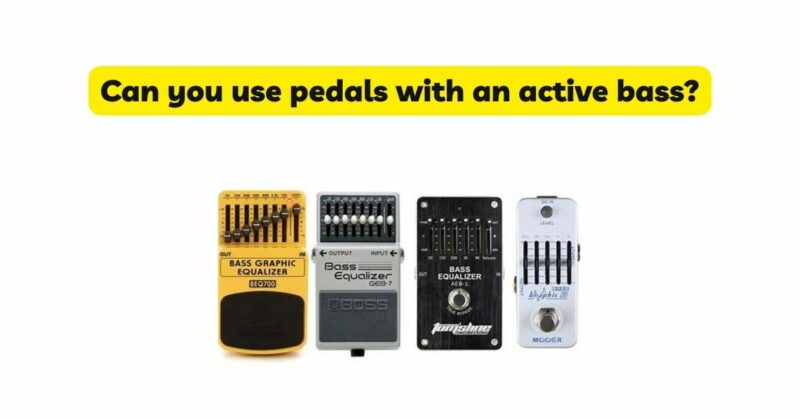Active bass guitars have gained popularity among bassists due to their enhanced tonal control and versatility. However, there is often uncertainty about whether pedals can be effectively used with active bass guitars. In this article, we will delve into the world of active bass guitars and examine the compatibility, benefits, and considerations of using pedals to further expand the sonic possibilities of these instruments.
Understanding Active Bass Guitars: Active bass guitars feature built-in electronics, including an onboard preamp powered by a battery. This preamp provides increased control over the instrument’s tone, often incorporating active EQ controls for precise frequency shaping. Active bass guitars offer a stronger output signal, extended frequency response, and the ability to sculpt the sound to suit various musical genres and playing styles.
Compatibility of Pedals with Active Bass Guitars: Using pedals with active bass guitars is not only possible but can also unlock a wealth of creative potential. Pedals are versatile tools that allow bassists to explore different effects, add unique textures, and shape their sound beyond the capabilities of the onboard preamp. Pedals can be integrated into the signal chain of an active bass guitar to further enhance and personalize the bass tone.
Benefits of Using Pedals with Active Bass Guitars:
- Expanded Sonic Palette: Pedals offer an extensive range of effects, such as distortion, modulation, delay, reverb, and more. By incorporating these effects into the signal chain, bassists can expand their sonic palette and create unique textures and atmospheres. Pedals provide the opportunity to experiment with different sounds and styles, enabling bassists to explore new musical territories.
- Customization and Versatility: Each pedal brings its own unique sonic character and functionality to the mix. By combining various pedals, bassists can tailor their sound to suit different musical contexts and playing situations. Pedals offer flexibility and allow for on-the-fly adjustments, enabling bassists to create dynamic and expressive performances.
- Expressive Playing: Pedals can enhance the expressiveness and dynamics of the bass guitar. For example, using a volume pedal or an expression pedal with a modulation effect can add depth and subtlety to the bass sound. These tools enable bassists to shape their playing dynamics and create captivating musical performances.
Considerations when Using Pedals with Active Bass Guitars:
- Signal Integrity: It is crucial to ensure that the pedals used with an active bass guitar maintain the integrity of the instrument’s tone. High-quality pedals with low noise levels and transparent signal processing are recommended to preserve the natural sound of the bass.
- Signal Level and Impedance: Active bass guitars typically have a hotter output signal compared to passive instruments. It is important to consider the signal level and impedance compatibility when incorporating pedals into the signal chain. Some pedals may handle the higher output signal of an active bass guitar differently, affecting the overall sound and response. Experimentation and careful pedal selection are necessary to achieve the desired tonal results.
- Power Supply Considerations: Active bass guitars already require battery power for the onboard preamp. Adding pedals to the signal chain may increase power consumption. Careful consideration should be given to power supply options, such as using dedicated power supplies or isolated pedalboard power sources, to ensure consistent and reliable performance.
- Tonality and EQ Considerations: Active bass guitars often offer onboard EQ controls that can shape the bass tone. When using pedals with an active bass, it is important to consider how the EQ settings of the instrument interact with the effects. Adjustments may be needed to maintain a balanced and cohesive sound.
Conclusion: Pedals can be effectively used with active bass guitars to expand sonic possibilities, add unique textures, and customize the bass tone. The compatibility, benefits, and considerations discussed in this article highlight the potential of using pedals with active bass guitars to unleash creativity and explore new musical avenues. As with any aspect of bass playing, experimentation, careful selection of pedals, and consideration of signal integrity and power supply are essential for achieving the desired results. Embrace the opportunity to incorporate pedals into your active bass setup and discover the limitless potential they offer to shape your unique sound.


